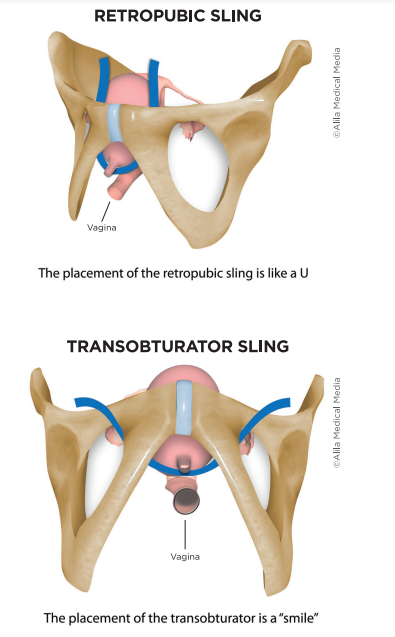Stress urinary incontinence (SUI) affects one in three women older than 45 years. Women most commonly develop SUJ from changes that happen in pregnancy or childbirth, which weaken the support to the urethra. Chronic coughing, constipation, obesity, aging, smoking, or extreme weight lifting can also cause SUI.
Stress Urinary Incontinence Is Treatable
There are several non-surgical treatments to improve symptoms:
• Keep your weight in a normal range and lose weight if you are overweight.
• Quit smoking.
• Do pelvic floor muscle exercises like Kegels (possibly with a physical therapist).
• Wear a pessary, a silicone device like a diaphragm that fits in the vagina.
You can also ask about urethral bulking injections, a low-risk, temporary procedure performed in the office.
If these options do not solve your urinary leakage, ask your medical provider about surgery. Mid-urethral sling procedures are the most commonly performed SUI operation. They are safe, effective, and improve the quality of life for many women.
About Mid-urethral Slings
During a mid-urethral sling procedure, the surgeon makes a small incision in the vagina and then two small skin incisions near the pubic bone or in the groin area. Using specially designed needles, the surgeon positions a thin piece of synthetic mesh under the urethra. Next, the surgeon pulls the ends of the mesh through the skin incisions and adjusts them to provide the right amount of tension under the urethra. After the procedure, your tissues grow through the weave of the mesh. This typically takes several weeks and helps to secure the sling.
The two general types of mid-urethral slings are retropubic slings and transobturator slings. Your surgeon will recommend a specific sling based on your individual needs.
Most women (more than 90 percent) are happy with the outcome of mid-urethral sling surgery. Serious complications are uncommon. However, for some women, sling surgery is not successful, and they may need more extensive surgery to correct the leakage.
Midurethral slings are the best-studied incontinence surgery in history. These studies consistently show high levels of success and patient satisfaction. The Food and Drug Administration (FDA) supports the safety and effectiveness of this surgery. The permanent mesh used in this surgery does not cause the high rates of complications that have been in the news related to mesh used for other types of vaginal surgery.
Prepping for Surgery
Sling procedures are commonly outpatient surgeries, meaning that you go home the same day of surgery. Or, the sling can be a part of bigger surgery, and you may have to stay overnight in the hospital. For example, you may need surgery to fix a prolapsed bladder, uterus, or rectum at the same time as your sling surgery.
Your surgeon will give you pre-surgery instructions. In most cases, sling surgery lasts less than 30 minutes. Based on your health, your doctor may recommend intravenous (IV) sedation or general anesthesia. You can go home once your pain is controlled and you’re able to empty your bladder. This may take a few hours. If you cannot empty your bladder immediately, you may have to temporarily use a catheter. This happens to about 30 percent of women. It can be due to swelling or the medicines used in surgery.
After Surgery
Give yourself about 3 to 10 days to recover from the surgery. You won’t have terrible pain, but you may feel easily fatigued while the incisions are healing. After that, you can likely go back to a normal schedule of activities. However, you’ll need to avoid heavy lifting and refrain from strenuous activities like sports for six weeks after the surgery. This will give your wounds time to heal and ensure the sling is firmly in place. You should avoid sex after surgery and ask your surgeon when you can become sexually active again. Also, ask when you can resume other medicines, including bladder medicines.
Every operation has risks:
- If you smoke, you are at greater risk for complications of sling surgery.
- Many women can develop a urinary tract infection (UTI) after surgery. If you experience burning, stinging, and urinary frequency, contact your doctor. An antibiotic may be required to treat a UTI.
- Take a stool softener to avoid constipation.
Other complications that require an evaluation:
Bleeding: Sometimes bleeding occurs where the mesh travels behind the pelvic bone and can form a hematoma (firm area of blood). The bleeding usually stops on its own, and your body will absorb it. If you have bruising or pressure in the vaginal area, alert your doctor.
Voiding difficulties: After sling surgery, many women have trouble urinating just after surgery. This may be due to swelling near the urethra, which means you will need to use a catheter temporarily. These changes are not permanent. Call your doctor’s office if you have trouble urinating.
Mesh exposure: The synthetic mesh under the urethra may become visible in the vagina. This may cause vaginal discharge and require further surgery to correct. If your doctor sees mesh in your vagina during your follow-up exam, the two of you will discuss what to do next.
THREE TAKEAWAYS
1. Midurethral slings are a safe and successful way to treat urine leakage that happens with exertion (coughing or laughing).
2. During the short outpatient surgery, the surgeon positions a thin piece of synthetic mesh under the urethra.
3. Ask questions of your surgeon about what to expect and stay in communication after surgery about any concerns you have.






